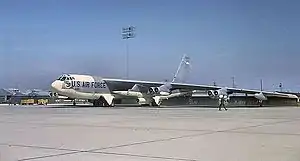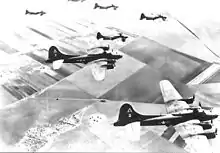342d Bombardment Squadron
The 342d Bombardment Squadron is an inactive United States Air Force unit. It was last assigned to the 4137th Strategic Wing. It was last stationed at Robins Air Force Base, Georgia and was inactivated on 1 February 1963.
| 342d Bombardment Squadron | |
|---|---|
 Boeing B-52G Stratofortress (57–6491) in SAC's arsenal of the early 1960s | |
| Active | 1942–1945; 1946–1963 |
| Country | |
| Branch | |
| Type | Bombardment |
| Engagements |
|
| Decorations |
|
| Insignia | |
| Emblem of the 342d Bombardment Squadron |  |
During World War II, the 342d Bombardment Squadron was a B-17 Flying Fortress squadron, assigned to the 97th Bombardment Group, Fifteenth Air Force. It earned two Distinguished Unit Citations.
History
World War II
The squadrom was established as a B-17 Flying Fortress heavy bomb squadron in early 1942, and trained under Third Air Force in Florida. While training it flew antisubmarine patrols over the Gulf of Mexico and the Florida Atlantic coastline. It was deployed to the European Theater of Operations (ETO) in June 1942, being assigned to VIII Bomber Command in England with B-17E aircraft.

Combat operations by the group began on 17 August 1942, when the squadron participated in the first Eighth Air Force heavy bomber mission of the war, attacking the Rouen-Sotteville marshalling yards in France. It then continued long-range strategic bombardment of occupied Europe, attacking airfields, marshaling yards, industries, naval installations, and other targets in France and the Low Countries.
The squadron was deployed to Algeria in November 1942, assigned to the new Twelfth Air Force in North Africa and upgraded to B-17Fs. It raided shipping in the Mediterranean Sea and airfields, docks, harbors, and marshaling yards in north Africa, southern France, Sardinia, Sicily, and the southern Italian mainland in a campaign to cut supply lines to German forces in north Africa. It helped force the capitulation of Pantelleria Island in June 1943. It bombed in preparation for and in support of the invasions of Sicily and southern Italy in the summer and fall of 1943.
The squadron was reassigned to the new Fifteenth Air Force and the Mediterranean Theater of Operations (MTO) in southern Italy, November 1943, flying a combination of B-17Fs and new B-17Gs. From Southern Italy it engaged in very long-range strategic bombardment missions, attacking targets in Italy, France, Germany, Czechoslovakia, Austria, Hungary, Romania, Bulgaria, Yugoslavia, and Greece, attacking oil refineries, marshalling yards, aircraft factories, and other strategic objectives. It participated in the first shuttle-bombing mission to Russia (Operation Frantic) in June 1944.
The squadron returned to the United States after the German capitulation in May 1945, and prepared for transition to Boeing B-29 Superfortress aircraft and deployment to Twentieth Air Force in the Pacific Theater. Japanese capitulation in August ended training activities; the squadron was demobilized and inactivated in October.
Strategic Air Command
The squadron was reactivated in 1946 under Strategic Air Command. It was equipped with B-29 Superfortresses and participated in numerous exercises, operational readiness inspections, and overseas deployments. One of these deployments involved the squadron's mission in West Germany and Berlin (then in East Germany) in July 1947. Just a month later, the unit was in Guam and Japan. It became part of SAC nuclear deterrent force.

The squadron began upgrading to the new B-50 Superfortress, an advanced version of the B-29 in 1949. The B-50 gave the unit the capability to carry heavy loads of conventional weapons faster and farther as well as being designed for atomic bomb missions if necessary.
By 1951, the emergence of the Soviet Mig interceptors in the skies of North Korea signaled the end of the propeller-driven B-50 as a first-line strategic bomber. The squadron received B-47 Stratojet jet bombers in 1955 and despite initial difficulties, the Stratojet became the mainstay of the medium-bombing strength of SAC all throughout the 1950s, deployed frequently to North Africa and England for REFLEX exercises. The squadron began sending its B-47s to AMARC at Davis–Monthan in 1959 when the aircraft was deemed no longer capable of penetrating Soviet airspace.
In 1960 the squadron was reassigned to the 4137th Strategic Wing, being re-equipped with B-52G Stratofortress intercontinental heavy bombers. It was reassigned to Robins Air Force Base, Georgia by SAC to disperse its heavy bomber force. It conducted worldwide strategic-bombardment training missions and provided nuclear deterrent. It was inactivated in 1963 when SAC inactivated its provisional Strategic Wings, redesignating them permanent Air Force Wings. The squadron was inactivated, with aircraft, personnel, and equipment being transferred to the 781st Bombardment Squadron.
Lineage

- Constituted as the "342d Bombardment Squadron" (heavy) on 28 January 1942
- Activated on 3 February 1942
- Re-designated "342d Bombardment Squadron", (heavy) on 6 March 1944
- Inactivated on 29 October 1945
- Re-designated "342d Bombardment Squadron", (very heavy) on 15 July 1946
- Activated on 4 August 1946
- Re-designated "342d Bombardment Squadron", (medium) on 28 May 1948
- Re-designated "342d Bombardment Squadron", (heavy) on 1 October 1959
- Discontinued and inactivated on 1 February 1963
Assignments
- 97th Bombardment Group, 3 February 1942 – 29 October 1945
- 97th Bombardment Group, 4 August 1946
- 97th Bombardment Wing, 16 June 1952
- 4137th Strategic Wing, 15 May 1960 – 1 February 1963
Stations
|
|
Aircraft
- Boeing B-17 Flying Fortress, 1942–1945
- Boeing B-29 Superfortress, 1946–1950
- Boeing B-50 Superfortress, 1950–1955
- Boeing B-47 Stratojet, 1955–1959
- Boeing B-52G Stratofortress, 1960–1963
See also
References
Notes
- B-17F-85-BO Fortress 42-30056 is in foreground.
Bibliography
![]() This article incorporates public domain material from the Air Force Historical Research Agency website http://www.afhra.af.mil/.
This article incorporates public domain material from the Air Force Historical Research Agency website http://www.afhra.af.mil/.
- Maurer, Maurer (1983). Air Force Combat Units of World War II. Maxwell AFB, AL: Office of Air Force History. ISBN 0-89201-092-4.

